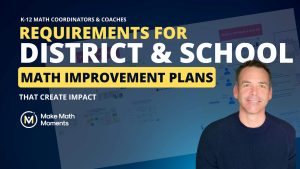Why Centralized Coaching Deployment Matters
“Coaches who are centrally deployed and report to the district—not individual school principals—ensure aligned priorities.”
One of the most critical, yet misunderstood, levers in a district’s math improvement plan is the structure and deployment of instructional coaches. It’s not just about hiring great people—it’s about placing them where they can succeed and protecting them from being redirected.
At first glance, it may seem logical for instructional coaches to report to the building principal. After all, principals lead the day-to-day operations of schools. But when it comes to sustained, system-wide math improvement, this structure often works against coherence.
The Problem with Site-Based Coaching Deployment
When principals guide a coach’s daily work, priorities can quickly shift toward immediate school needs—needs that may not align with the district’s broader math goals. In many cases, coaches find themselves pulled into non-instructional tasks like classroom coverage, supervision, or managing behaviour plans. Over time, their role as instructional leaders erodes. Even more concerning, site-based deployment leads to fragmentation across the system. Each school begins to chart its own course for professional learning, with little connection to a shared district vision. Coaches, operating in isolation, lose the benefit of a collaborative network and often go without the kind of content-based learning and support that helps their practice deepen over time. Without coordination from the center, even the best coaches struggle to move the system forward.
Coaches succeed not only because of how they provide support, but because of the relationships they build. When a coach is spread across too many sites, they struggle to establish trust, credibility, and a rhythm of collaboration. Teachers are less likely to seek feedback or invite a coach into their practice when that coach feels like a stranger.
That’s why we recommend:
A centrally deployed coach should be assigned to no more than one or two schools.
When coaches are centrally deployed and accountable to a district-level math lead—not an individual school principal—their work remains anchored to the district’s math vision and Key Results. This structure ensures coaches stay focused on system-wide instructional priorities rather than being redirected by site-specific demands. Their time is better protected from being repurposed for supervision or administrative tasks, and they remain connected to a broader coaching network with access to shared tools, learning, and collaboration.
When coaching assignments are thoughtfully limited in scope—ideally no more than one or two schools per coach—the benefits of central deployment are fully realized. Coaches are able to embed themselves in the daily rhythm of school life: joining PLCs, supporting lesson planning, responding to teacher needs, and building trust through presence. This balance—central direction with localized consistency—allows coaches to foster deep relationships without losing sight of the larger district vision.
Central Deployment Ensures Focus and Alignment
When coaches are centrally deployed and accountable to a district-level math lead—not an individual school principal—their work remains anchored to the district’s math vision and Key Results. This structure ensures:
- Coaches focus on system-wide instructional priorities, not site-specific or shifting agendas.
- Their time is protected from being repurposed for non-instructional duties.
- They are part of a coaching network, supported through shared learning, tools, and planning.
What Central Deployment Should Look Like
- Coaches are assigned by the district – to one or two schools, with input from principal needs—but accountable to a central math lead or team.
- Coaching priorities are aligned to district-wide Key Results and math vision.
- Coaches receive ongoing training and calibration with their peers.
- Principals are still partners—but not the coach’s supervisor. This fosters healthy collaboration over directive control.
A powerful example of this model comes from West Carrollton School District, where the district restructured its PD and coaching support. Coaches participated in district-led learning, used common observation tools, and focused their efforts on system-defined goals like number sense and fluency. Principals were involved—but coaches knew their accountability was to the broader vision, not just the site leader’s preferences. This created coherence across schools and enabled rapid sharing of bright spots.
The Continuum of District Office Support
Here is a 4-level rubric for district office support of school leaders. It acts as a mirror for your current practices—and a map for where to grow.
| Level | Description |
| 0 – No Engagement | No effort made to involve principals in math improvement. All work occurs at the central or teacher level. |
| 1 – Awareness Only | Principals are informed of initiatives but receive no structured support. Coaches operate independently. |
| 2 – Occasional Involvement | Principals are invited to math PD or receive isolated PD sessions. Capacity-building is sporadic. |
| 3 – Coordinated Support | Principals, coaches, and central office collaborate on goals. Ongoing PD supports administrator capacity. |
| 4 – Aligned and Accountable | Observation tools align to math goals. Principals are held accountable to math-related KRs. Resources are adjusted to support priorities. |
The Continuum of District Office Support outlines how deeply principals and other site leaders are engaged in the district’s math improvement plan. As the levels progress from No Engagement to Aligned and Accountable, leaders are not just participating more frequently—they’re being positioned to succeed. This growth mirrors the 4 Components of Teacher Adoption, adapted here to reflect what leaders need in order to champion and sustain instructional change.
1. Clarity: A Shared Vision and Purpose
At the lower levels of the continuum, school leaders often lack a clear understanding of the district’s instructional goals. They may be informed of new initiatives but not grounded in the why. At higher levels, clarity becomes a driving force. Principals are brought into the district’s math vision early and often. They understand the goals, the Key Results (KRs), and their role in achieving them — and their role in defining school level key-results. This shared clarity allows them to reinforce the same expectations with teachers, ensuring alignment from the classroom to the boardroom.
2. Modeling: Experiencing What They’re Expected to Lead
It’s one thing to ask a principal to support a fluency strategy or use HQIM walkthrough tools—but it’s another for them to experience those tools firsthand. In high-functioning systems (Levels 3 and 4), leaders are not just attending math PD—they’re participating as learners. They sit in on coaching labs, co-lead PLCs, and engage in professional learning alongside teachers. This modeling helps them internalize what effective math instruction looks like, so they can more confidently support it.
3. Confidence: Belief in Their Ability to Lead the Work
Confidence doesn’t come from job titles—it comes from preparation and support. In systems that linger at Levels 1 or 2, principals are often expected to support math improvement without any real capacity-building. But at higher levels, they’re given targeted training, tools, and protected time to deepen their instructional leadership. As their understanding grows, so does their belief that they can meaningfully contribute—not just manage—math improvement efforts.
4. Support and Accountability: Structures That Sustain Implementation
Finally, even the most willing leaders can falter without consistent follow-up. In systems operating at Level 4, support isn’t sporadic—it’s built into the calendar, the observation tools, and the feedback loops. Principals are held accountable to math-related Key Results, and district leaders ensure they have the resources (time, staffing, materials) to meet them. This isn’t compliance—it’s commitment, with mutual responsibility between the district and site leaders.
The higher a district scores on the Continuum of District Office Support, the more likely it is that school leaders are positioned for success. And just like with teachers, when leaders experience clarity, modeling, confidence-building, and consistent support, they don’t just comply with improvement plans—they drive them. By attending to these four components, districts transform principals from passive recipients of change into active stewards of instructional excellence.
When Coaching Lacks System Alignment
One of the most well-documented breakdowns in district-level instructional improvement happens when coaching roles are poorly defined or inconsistently supported across schools. In Systems for Instructional Improvement, Cobb et al. (2018) share findings from their longitudinal research on large urban districts attempting to scale instructional change. They found that in many cases, even when coaches were hired with the intent of supporting high-quality instructional materials and practices, their impact was severely diluted when they reported to principals rather than a centralized instructional team.
In these districts, principals often repurposed coaches to meet immediate site-based needs—such as managing student behavior, covering classes, or assisting with general administrative tasks. The result was a loss of instructional coherence: each coach operated according to site-specific priorities, PD became fragmented, and the system’s ability to improve at scale was compromised.
Only when districts restructured their coaching models—deploying coaches centrally, defining clear roles aligned with district-wide goals, and building the capacity of school leaders to support that work—did they begin to see measurable improvements in instructional practice and student outcomes. These changes were often accompanied by regular calibration sessions, shared observation tools, and scheduled reflection cycles across schools—all critical components of a functioning “system of practice.”
By building district structures that:
- empower administrators,
- deploy coaching strategically, and
- define clear instructional goals,
you increase your odds of diffusion—the ability of strong practices to spread across buildings, grades, and teachers.
This structure is not just practical—it’s supported by research. Cobb et al. (2018) emphasize the need for “systems of practice” that build vertical coherence—the deliberate alignment of goals, practices, and roles from the district office to the classroom. Without this coherence, instructional improvement efforts tend to remain isolated and unsustainable. Similarly, Elmore (2004) argues that lasting improvement only occurs when leadership and instructional capacity are developed in tandem across the system, rather than in fragmented pockets. In other words, when coaches are aligned to the same vision and supported through a system-wide structure, their impact grows—not just within a single school, but across the district.
A Final Reminder for Leaders
The most powerful systems are designed to sustain themselves.
That means:
- Principals don’t just “host” PD—they model, monitor, and champion the work.
- District staff don’t just create plans—they steward them across years.
- Coaches don’t float aimlessly—they are embedded, aligned, and protected.
If you’re planning for next year and want your coaching program to drive measurable change—not just activity—let’s talk.
➡️ Book a call with our team, and we’ll walk through how to design a focused, research-backed coaching structure that aligns with your goals and builds lasting momentum.
References:
Cobb, Paul, Kara Jackson, Erin Henrick, and Thomas M. Smith. Systems for Instructional Improvement: Creating Coherence from the Classroom to the District Office. Harvard Education Press, 2021.
👉 https://www.hepg.org/hep-home/books/systems-for-instructional-improvement
Elmore, Richard F. School Reform from the Inside Out: Policy, Practice, and Performance. Harvard Education Press, 2004.
👉 https://www.amazon.ca/School-Reform-Inside-Out-Performance/dp/1891792245
Rogers, Everett M. Diffusion of Innovations. 5th ed., Free Press, 2003.
👉 Head here
Leithwood, Kenneth, Karen Seashore Louis, Stephen Anderson, and Kyla Wahlstrom. How Leadership Influences Student Learning. Wallace Foundation, 2004.
👉 Head here.






